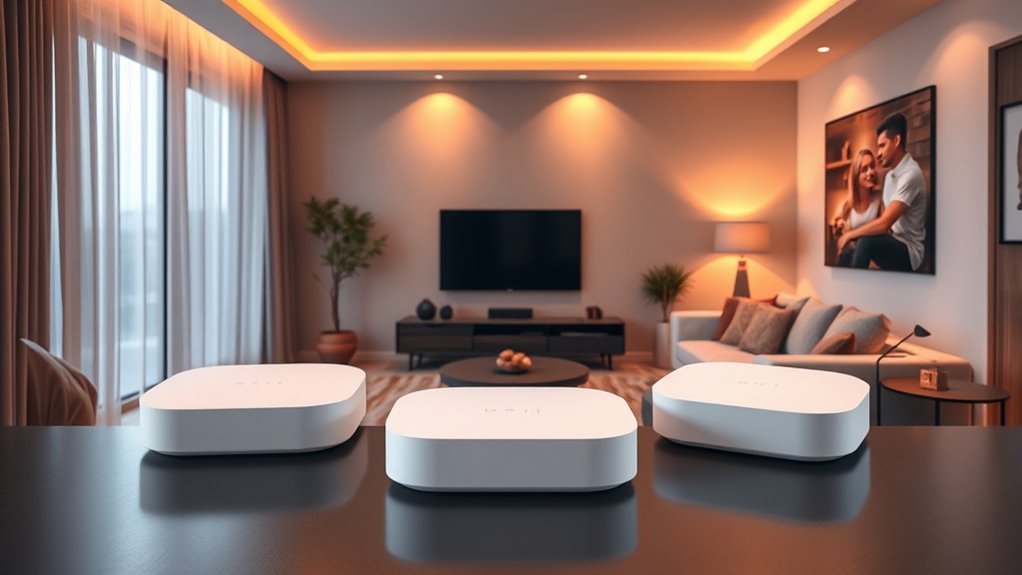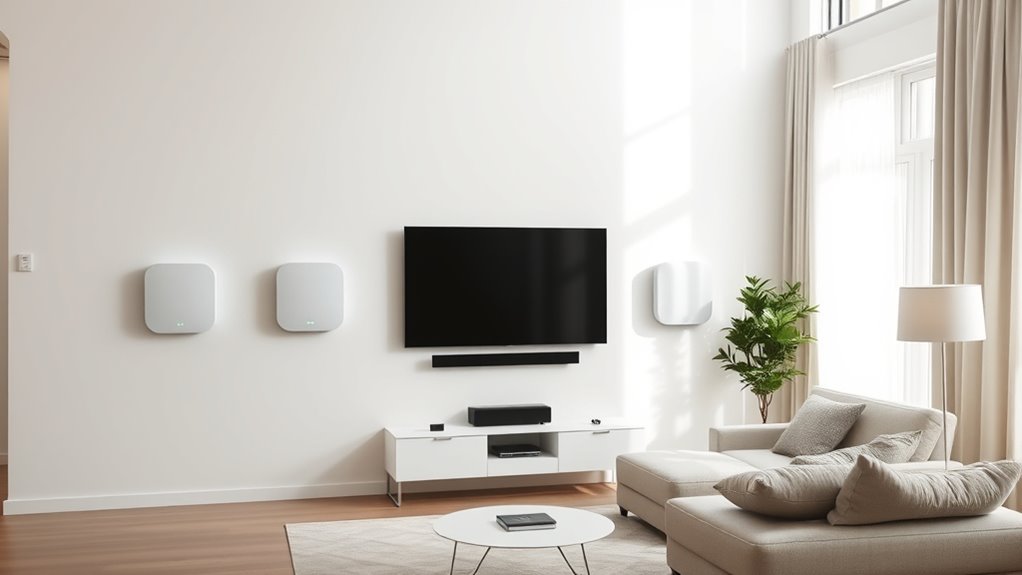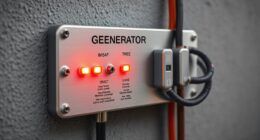If you’re looking to boost your home network in 2025, I recommend exploring some of the top mesh WiFi systems like the TP-Link Deco AX3000, Amazon eero 6+, and NETGEAR Orbi 770. These systems support Wi-Fi 6 and Wi-Fi 7, offering extensive coverage and handling dozens of devices simultaneously. They’re easy to set up and perfect for large or complex homes. Keep exploring to find the best fit for your needs and budget.
Key Takeaways
- Top mesh WiFi systems support Wi-Fi 6, Wi-Fi 6E, and Wi-Fi 7 for faster speeds and higher device capacity in 2025.
- Coverage ranges from 4,500 sq.ft. to over 10,000 sq.ft., ideal for large homes and complex layouts.
- Features like seamless roaming, AI-Roaming, and multi-gig ports ensure reliable, high-speed connectivity for multiple devices.
- Easy setup via mobile apps, with advanced security options such as WPA3 and NETGEAR Armor, enhance network safety.
- Recognized systems include Amazon eero 6+, Tenda MX12, NETGEAR Orbi 970, Deco series, and outdoor bridges, catering to diverse needs.
TP-Link Tri-Band WiFi 7 Mesh System (3-Pack)
The TP-Link Tri-Band WiFi 7 Mesh System (3-Pack) stands out as the ideal choice for large households or demanding smart homes that need seamless, high-speed coverage. With speeds up to 10 Gbps across three bands—6GHz, 5GHz, and 2.4GHz—it guarantees fast, reliable connectivity throughout your home. Covering up to 7,600 sq.ft., it supports over 200 devices simultaneously, making it perfect for busy households. Its advanced features like multi-gig ports, AI-Roaming, and robust security via HomeShield provide both performance and peace of mind. Setup is simple through the Deco app, giving you easy control over your entire network.
Best For: households or smart homes requiring extensive, high-speed Wi-Fi coverage with support for numerous devices and advanced security features.
Pros:
- Ultra-fast speeds up to 10 Gbps across three bands for seamless streaming and gaming
- Covers up to 7,600 sq.ft. and supports over 200 devices simultaneously
- Easy setup and management via the Deco app with AI-Roaming and customizable network segmentation
Cons:
- Higher price point compared to traditional routers, around $300 for a 3-pack
- May be overkill for smaller homes or users with minimal device needs
- Advanced features like VPN and multi-gig ports may require some technical knowledge to optimize
TP-Link Dual-Band BE5000 WiFi 7 Mesh Wi-Fi System (3-Pack)
If you’re looking for a mesh WiFi system that can handle the demands of modern devices and large homes, the TP-Link Deco BE25 with Wi-Fi 7 technology is an excellent choice. It offers dual-band capabilities with speeds up to 5 Gbps, supporting over 150 devices simultaneously. With extensive coverage of up to 6,600 sq. ft., four high-gain antennas ensure strong, reliable signals throughout your home. Setup takes less than 10 minutes via the TP-Link app, and AI-Roaming keeps devices seamlessly connected. Plus, advanced security features like HomeShield and support for wired backhaul make this system both fast and secure for any large household.
Best For: households with large areas and many devices seeking fast, reliable Wi-Fi 7 coverage with easy setup and advanced security features.
Pros:
- Supports Wi-Fi 7 with speeds up to 5 Gbps and over 150 device capacity for future-proof performance.
- Extensive coverage of up to 6,600 sq. ft. with four high-gain antennas, ideal for large homes.
- Quick setup in less than 10 minutes via the TP-Link app, with seamless device roaming thanks to AI-Roaming.
Cons:
- Higher price point compared to older Wi-Fi systems, reflecting advanced technology.
- Limited to a 3-pack, which may not be sufficient for extremely large or multi-story homes without additional units.
- Requires compatible devices to fully utilize Wi-Fi 7 features; older devices may not benefit from the latest speed enhancements.
TP-Link Deco AX3000 WiFi 6 Mesh System (Deco X55)
For homeowners seeking seamless, high-speed connectivity across large spaces, the TP-Link Deco AX3000 WiFi 6 Mesh System (Deco X55) offers an excellent solution. It covers up to 6,500 square feet with reliable Wi-Fi 6, eliminating dead zones and weak signals. Supporting up to 150 devices, it ensures smooth streaming and fast data transfer through dual-band speeds of 2402 Mbps and 574 Mbps. Each unit has three Gigabit Ethernet ports, and the system can use Ethernet backhaul for stability. Setup is straightforward via the Deco app, and the system features advanced security, making it a flexible, high-performance choice for a modern home network.
Best For: homeowners needing extensive, high-speed Wi-Fi coverage across large spaces with reliable device connectivity and easy management.
Pros:
- Covers up to 6,500 sq ft with seamless Wi-Fi 6 mesh technology, reducing dead zones.
- Supports up to 150 devices with fast dual-band speeds for smooth streaming and data transfer.
- Easy setup via the Deco app with advanced security features for a secure home network.
Cons:
- Requires multiple units for optimal coverage, which can increase overall cost.
- Wired Ethernet backhaul setup may be complex for some users unfamiliar with networking.
- Limited to three Ethernet ports per unit, which might be insufficient for very wired-heavy setups.
TP-Link Deco AXE5400 Tri-Band WiFi 6E Mesh System
Those seeking seamless, high-speed WiFi coverage across large homes or properties will find the TP-Link Deco AXE5400 Tri-Band WiFi 6E Mesh System to be an excellent choice. Covering up to 7,200 sq.ft., it replaces routers and extenders with three gigabit ports per unit and speeds up to 5,400 Mbps, including a new 6 GHz band for less interference. Its AI-driven mesh optimizes performance based on environment and user behavior, while setup is quick via the Deco app. With support for all major ISPs, robust security, and easy expansion, the Deco XE75 offers reliable, future-proof connectivity ideal for busy, large-scale networks.
Best For: households or large properties seeking reliable, high-speed WiFi coverage with easy setup and expansion.
Pros:
- Covers up to 7,200 sq.ft with seamless mesh networking
- Supports WiFi 6E tri-band technology for high speeds and reduced interference
- Easy setup through the Deco app with management and voice control features
Cons:
- Slightly expensive compared to traditional routers and simpler mesh systems
- Device identification within the app can be generic and less intuitive
- Requires a compatible modem for most ISP connections, adding to initial setup complexity
Amazon eero 6+ Mesh WiFi System (3-Pack)
The Amazon eero 6+ Mesh WiFi System (3-Pack) stands out as an ideal choice for homes with high-speed internet plans and multiple connected devices, thanks to its gigabit speeds and support for over 75 devices simultaneously. Covering up to 4,500 sq ft, it features Wi-Fi 6 dual-band technology, ensuring fast, reliable connections for streaming, gaming, and work. Its built-in smart home hub supports Zigbee, Thread, and Alexa, simplifying device management. Easy to set up via the eero app, it offers consistent performance, minimal dead zones, and automatic security updates. This system is perfect for busy households seeking robust, future-proof WiFi with excellent coverage and device capacity.
Best For: households with high-speed internet plans and numerous connected devices seeking reliable, fast WiFi coverage and smart home integration.
Pros:
- Supports gigabit speeds and over 75 devices simultaneously, ideal for busy homes and streaming.
- Easy setup and management through the eero app, with automatic security updates for peace of mind.
- Built-in smart home hub compatible with Zigbee, Thread, and Alexa, simplifying smart device connectivity.
Cons:
- Higher initial cost compared to traditional routers or extenders.
- Wired connection quality may vary depending on proper Ethernet or MoCA setup.
- Limited to a 1-year warranty, with ongoing subscription options like eero Plus for enhanced features.
Amazon eero 6 Mesh Wi-Fi System (3-Pack)
If you’re looking for a reliable, easy-to-set-up mesh Wi-Fi system that covers large homes, the Amazon eero 6 Mesh Wi-Fi System (3-Pack) stands out as an excellent choice. It supports internet plans up to 500 Mbps and covers up to 5,000 sq ft with a router and two extenders. Featuring Wi-Fi 6 dual-band technology, it delivers fast speeds often exceeding 500 Mbps and supports over 75 devices simultaneously. The system is simple to install via the eero app and integrates seamlessly with Alexa and smart home devices. With reliable performance, sleek design, and expandable coverage, it’s a solid option for whole-home Wi-Fi.
Best For: those seeking an easy-to-install, reliable mesh Wi-Fi system for large homes with multiple devices and smart home integration.
Pros:
- Supports Wi-Fi 6 for faster speeds and improved device capacity
- Covers up to 5,000 sq ft with a 3-pack, ideal for large homes
- Easy setup via the eero app with seamless Alexa integration
Cons:
- Limited advanced network management features and local controls
- Some users experience DHCP or connectivity issues with certain ISPs
- Certain features and functionalities may require a subscription or have bugs
Tenda AX3000 WiFi 6 Mesh System Nova MX12
For large homes seeking reliable, high-speed Wi-Fi coverage without breaking the bank, the Tenda AX3000 WiFi 6 Mesh System Nova MX12 stands out as an excellent choice. Covering up to 7,000 sq.ft., it replaces traditional routers and extenders, eliminating dead zones. With speeds up to 2976 Mbps and support for over 160 devices, it handles streaming, gaming, and smart home gadgets seamlessly. Easy to set up via the app, it offers flexible network management and parental controls. While some users report Ethernet backhaul issues and limited support, overall, it delivers strong performance and coverage at a competitive price point.
Best For: large households seeking comprehensive, high-speed Wi-Fi coverage that is easy to set up and manage on a budget.
Pros:
- Covers up to 7,000 sq.ft. with seamless Wi-Fi coverage ideal for large homes
- Supports over 160 devices simultaneously with fast Wi-Fi 6 speeds up to 2976 Mbps
- Easy to install and manage via the Tenda app, with flexible network customization and parental controls
Cons:
- Ethernet backhaul connections between nodes can be unreliable or fail to work properly
- Limited customer support, with some users experiencing unresponsive service issues
- Occasional Wi-Fi slowdowns, node crashes under heavy load, and auto-reboot schedules may affect performance
NETGEAR Orbi 970 Series Mesh WiFi 7 System
Designed for large homes and demanding users, the NETGEAR Orbi 970 Series Mesh WiFi 7 System delivers blazing-fast speeds up to 27Gbps, making it ideal for streamers, gamers, and remote workers who need reliable, high-bandwidth connections across extensive areas. Its exclusive Quad-band technology with Enhanced Dedicated Backhaul guarantees consistent performance and coverage up to 10,000 sq. ft., even outdoors. The system includes a router and two satellites, with a 10 Gig internet port for multi-gig connections. Easy to set up and manage via the Orbi app, it also features built-in security, including NETGEAR Armor, to keep your network safe.
Best For: households and professionals in large homes or complex layouts seeking ultra-fast, reliable WiFi with extensive coverage and advanced security features.
Pros:
- Supports speeds up to 27Gbps, ideal for high-bandwidth activities like streaming, gaming, and remote work.
- Covers up to 10,000 sq. ft. with quad-band technology and dedicated backhaul for consistent performance.
- Includes built-in security with NETGEAR Armor for comprehensive device and network protection.
Cons:
- Higher price point compared to other mesh systems, reflecting its advanced features.
- Some users experience connectivity issues such as outdoor range limitations and device drop-offs.
- Setup and reliability may vary, with occasional glitches reported by users, especially when compared to simpler systems like Eero.
TP-Link Deco Mesh AC1900 WiFi System (Deco S4)
The TP-Link Deco Mesh AC1900 WiFi System (Deco S4) stands out as an ideal choice for large homes and busy households that need reliable, seamless coverage throughout every room. Its Deco Mesh technology delivers fast speeds and strong signals in all directions, covering up to 5,500 square feet with three units. It supports up to 100 devices with 3×3 6-Stream AC1900 speeds and automatically switches devices between units for best performance. Setup is quick via the Deco app, and it’s compatible with major ISPs. Plus, it offers parental controls, Alexa integration, and wired Ethernet backhaul options, making it a versatile, user-friendly mesh system.
Best For: households needing reliable, seamless WiFi coverage across large areas with multiple devices and smart home integration.
Pros:
- Covers up to 5,500 square feet with a 3-unit mesh system for extensive home coverage
- Supports up to 100 devices with fast AC1900 speeds and seamless device switching
- Easy setup via the Deco app, compatible with major ISPs, and includes parental controls and Alexa support
Cons:
- May require a separate modem depending on the internet provider
- Limited to AC1900 speeds, which may be lower than higher-end systems for very demanding users
- No built-in WiFi 6 or WiFi 6E support for future-proofing and faster speeds
TP-Link Dual-Band WiFi 7 Mesh System (Deco BE23) (3-Pack)
The TP-Link Deco BE23 Mesh System stands out as an excellent choice for anyone seeking future-proof Wi-Fi coverage that can handle a multitude of devices seamlessly. With up to 6,500 sq. ft of coverage, it supports over 150 devices at speeds up to 3.6 Gbps, perfect for streaming, gaming, and smart home gadgets. Its Wi-Fi 7 features like Multi-Link Operation, beamforming, and OFDMA guarantee fast, reliable connections with low latency. Wired backhaul options and advanced security via HomeShield add to its appeal. Easy to set up through the Deco app, this system combines high performance with smart management, making it a top contender for modern home networks.
Best For: those seeking a future-proof, high-capacity Wi-Fi 7 mesh system ideal for large homes, streaming, gaming, and smart device integration.
Pros:
- Covers up to 6,500 sq. ft with seamless coverage for multiple devices
- Supports over 150 devices with high speeds up to 3.6 Gbps
- Advanced Wi-Fi 7 features like Multi-Link Operation, beamforming, and OFDMA for reliable, low-latency connections
Cons:
- Initial setup can be challenging due to non-descriptive device labels and MAC address identification
- Parental controls do not extend to wired devices like smart TVs
- Alexa integration offers limited voice command capabilities
Amazon eero Pro 6E Mesh WiFi System (3-Pack)
If you’re looking for a mesh WiFi system that can handle a large home and numerous devices effortlessly, the Amazon eero Pro 6E 3-pack stands out as an excellent choice. It supports internet plans up to 2.5 Gbps and covers up to 6,000 sq. ft., connecting over 100 devices smoothly. With Wi-Fi 6E, it offers fast speeds, lower latency, and access to the 6 GHz band, even for non-Wi-Fi 6E devices. Setup is straightforward via the eero app, and its TrueMesh technology guarantees reliable coverage with minimal dead spots. It’s perfect for streaming, gaming, and smart home devices in multi-story homes.
Best For: households seeking a reliable, high-speed mesh Wi-Fi system capable of supporting extensive coverage and numerous devices across large or multi-story homes.
Pros:
- Supports internet plans up to 2.5 Gbps with coverage up to 6,000 sq. ft. for large homes.
- Easy setup via the eero app with seamless integration and minimal configuration.
- Handles over 100 devices simultaneously with stable, fast Wi-Fi, ideal for streaming, gaming, and smart home devices.
Cons:
- Requires a compatible internet plan to fully utilize gigabit speeds.
- No web-based management interface; limited to app control.
- May be more expensive than traditional routers or smaller mesh systems, especially for users with less demanding needs.
Google Wifi Mesh WiFi System (AC1200, 3 Pack)
For large homes or spaces with challenging layouts, the Google Wifi AC1200 Mesh WiFi System (3 Pack) offers a reliable and easy-to-manage solution. Each unit covers about 1500 square feet, creating a mesh network that blankets up to 4500 square feet. It automatically manages signal strength and switches between 2.4 GHz and 5 GHz bands for ideal performance. Setup is quick and simple through the Google Home app, taking around 15 minutes. The system supports multiple devices with stable speeds, eliminates dead spots, and is praised for ease of use and reliable coverage. It’s a solid choice for large or complex homes seeking dependable WiFi.
Best For: large households or spaces with challenging layouts seeking reliable, easy-to-manage WiFi coverage.
Pros:
- Scalable coverage up to 4500 square feet with a 3-pack system
- Quick and simple setup via the Google Home app in about 15 minutes
- Seamless performance with automatic band switching and support for multiple devices
Cons:
- May require additional units for homes with thick walls or extensive dead spots
- Limited control over advanced network configurations for tech-savvy users
- Some users report difficulty resolving dead spots behind concrete walls
Reyee Mesh WiFi System AX3200 Router (1-Pack)
Anyone seeking seamless, high-speed Wi-Fi coverage across a large home can benefit from the Reyee Mesh WiFi System AX3200 Router. This smart Wi-Fi 6 router covers up to 3,000 sq. ft. indoors and extends beyond 6,000 sq. ft. with additional units, supporting up to 110 devices simultaneously. It features dual-band signals, 2400Mbps on 5GHz, and 800Mbps on 2.4GHz, reducing buffering and latency. With eight omnidirectional antennas, beamforming, and advanced antenna systems, it delivers strong signals through walls. Easy to set up and expand, this system keeps devices connected smoothly across large, multi-story homes and outdoor spaces.
Best For: homeowners and large households seeking reliable, high-speed Wi-Fi coverage across expansive indoor and outdoor spaces with multiple connected devices.
Pros:
- Covers up to 3,000 sq. ft. indoors and extends beyond 6,000 sq. ft. with additional units, ideal for large homes.
- Supports up to 110 devices simultaneously with Wi-Fi 6 technology, ensuring smooth performance for multiple smart gadgets.
- Easy to set up and expand, with seamless mesh networking for reliable roaming and minimal dead zones.
Cons:
- Some users report inconsistent speeds or disconnections after initial setup.
- The system is priced higher than basic routers, which may be a consideration for budget-conscious buyers.
- As a relatively new product, customer support and firmware updates may have limited track record.
Wireless Bridge CPE609P 1000Mbps Outdoor WiFi Bridge with 2 Gigabit LAN Ports
The Wireless Bridge CPE609P stands out as the ideal solution for outdoor networking needs, especially when long-range, high-speed connectivity is essential. I find its 1000Mbps point-to-point WiFi impressive, supporting transmission up to 5 km (3.1 miles). With a robust 14dBi antenna and IP65 weatherproof casing, it handles harsh conditions from -22°F to 149°F. Setup is straightforward with plug-and-play, DIP switches, and a WEB GUI for real-time monitoring. The dual Gigabit LAN ports support speeds up to 1200Mbps, making it perfect for extending WiFi, bridging networks between buildings, or enhancing surveillance systems outdoors.
Best For: outdoor network installers, large property owners, and surveillance setups needing long-range, high-speed wireless connectivity.
Pros:
- Supports up to 1000Mbps WiFi speed with long-range transmission up to 5 km (3.1 miles)
- Durable IP65 weatherproof casing suitable for harsh outdoor conditions
- Easy to install with plug-and-play setup, DIP switches, and WEB GUI monitoring
Cons:
- Occasional reports of TCP/IP instability in some setups
- Some users experience issues with Ethernet cables or mounting hardware
- Higher cost compared to indoor or lower-spec outdoor wireless devices
NETGEAR Orbi 770 Series Tri-Band WiFi 7 Mesh Network System
The NETGEAR Orbi 770 Series Tri-Band WiFi 7 Mesh Network System stands out as an ideal choice for those seeking ultra-fast, reliable internet coverage across large homes or small offices. It delivers speeds up to 11Gbps and covers up to 8,000 square feet with seamless 360° WiFi, supporting up to 100 devices, including smart home gadgets and security cameras. Easy to set up via the Orbi app, it’s compatible with any internet provider and offers multi-gig Ethernet ports. Users rave about its speed, stability, and coverage, though some report occasional drops and firmware glitches. Overall, it’s a powerful, premium option for robust home networking.
Best For: home users and small offices seeking ultra-fast, reliable, whole-home WiFi coverage with support for multiple devices and smart home integration.
Pros:
- Delivers speeds up to 11Gbps and broad coverage up to 8,000 sq. ft.
- Easy setup via the Orbi app with user-friendly management features.
- Supports multi-gig Ethernet ports for wired connections and multi-device stability.
Cons:
- Some users experience occasional WiFi drops and firmware glitches over time.
- Limited VPN support, only offering OpenVPN and not Wireguard.
- Customer feedback indicates mixed reliability and support experiences.
Factors to Consider When Choosing Mesh Wifi Systems

When choosing a mesh WiFi system, I focus on factors like coverage area, device compatibility, and speed to guarantee it meets my needs. Security features and easy setup are also important for a seamless experience. Considering these points helps me find a system that’s reliable, secure, and simple to install.
Coverage Area Needs
Selecting the right mesh WiFi system depends heavily on understanding your coverage area needs. First, I recommend measuring your total square footage to choose a system that covers at least that area, typically between 2,000 and over 10,000 square feet. Consider the number of floors and room layouts—multi-story homes usually need more nodes for consistent coverage. Don’t forget about obstacles like thick walls, basements, or outdoor spaces, which can weaken signals and require additional units. If you plan to add smart devices or expand later, opt for a system with a larger coverage capacity to future-proof your setup. Always compare the manufacturer’s coverage estimates with your actual space to guarantee reliable Wi-Fi throughout your entire property.
Device Compatibility
Making sure your mesh WiFi system supports your devices’ standards and features is essential for seamless connectivity. First, verify it supports the Wi-Fi standards your devices use, like Wi-Fi 6, 6E, or 7, to guarantee optimal performance. It’s also important to confirm compatibility with your smart home gadgets, streaming devices, and gaming consoles to avoid connection issues. Additionally, check that all mesh nodes and routers support the same security protocols, such as WPA3, to keep your network safe. You should also consider whether the system can handle the number of devices you plan to connect simultaneously, ensuring smooth operation. Lastly, ensure the system’s app or management interface works with your smartphone or tablet’s OS—iOS or Android—for easy setup and control.
Speed and Bandwidth
The speed and bandwidth of a mesh WiFi system are essential factors that directly impact your network’s performance, especially with multiple devices connected simultaneously. The system’s Wi-Fi standard—like Wi-Fi 6, Wi-Fi 6E, or Wi-Fi 7—determines its maximum data transfer rates. Dual-band systems typically support up to 3.6 Gbps, while tri-band setups can exceed 5.4 Gbps, offering more bandwidth for heavy use. Wi-Fi 7 takes it further with 320 MHz channels and 4K-QAM modulation, delivering faster speeds and greater capacity. The total bandwidth is divided across multiple bands, with dedicated backhaul channels ensuring consistent performance. High-speed mesh systems can handle 4K and 8K streams, gaming, and large downloads simultaneously without lag or buffering.
Security Features
Security features are a crucial aspect to contemplate when choosing a mesh WiFi system because they directly protect your data and connected devices from threats. Modern systems often include WPA3 encryption, which offers stronger protection for data transmission. Many also feature automatic firmware updates and cybersecurity tools like threat detection and malware blocking, reducing vulnerabilities. Support for VPN client and server functions allows secure remote access to your home network, enhancing privacy. Built-in parental controls and device management tools help restrict access and monitor activity, adding an extra security layer. Additionally, choosing systems that meet industry security standards and certifications ensures your network adheres to best practices for safeguarding your privacy and data integrity. Prioritizing these features helps keep your home network safe and secure.
Setup Simplicity
Choosing a mesh WiFi system with setup simplicity can save you time and frustration. Many systems now feature dedicated mobile apps or web interfaces that guide you through installation step-by-step, making setup straightforward even for beginners. These systems often require minimal hardware connections—usually just plugging in the primary unit and adding satellite nodes wirelessly or via Ethernet. They support auto-detection of internet connections and automatic network configuration, reducing the need for manual input. Clear instructions, visual guidance, and minimal configuration options help guarantee a quick, hassle-free deployment. Compatibility with smartphones and tablets makes setup even easier, especially with features like barcode scanning or one-touch add functions. Overall, a simple setup process means you can enjoy your improved WiFi network faster and with less stress.
Wired Backhaul Options
Have you considered how wired backhaul options can impact your mesh WiFi system’s performance? Connecting nodes with Ethernet cables reduces wireless congestion, boosting speed and stability. Wired backhaul supports higher data transfer rates and lower latency compared to wireless links, making your network more reliable—especially in large or complex homes. However, setting up Ethernet backhaul may involve extra installation work, like running cables between nodes, which can be a consideration depending on your home layout. Some mesh systems come with multi-gigabit Ethernet ports, allowing compatibility with faster internet plans and future-proofing your setup. Overall, wired backhaul enhances network stability and performance, providing a seamless experience for multiple devices and high-bandwidth activities. It’s an excellent option if you’re seeking maximum speed and reliability.
Expandability Potential
When selecting a mesh WiFi system, considering its expandability potential is essential to guarantee your network can grow smoothly as your needs change. A system’s ability to seamlessly add compatible nodes without sacrificing performance is key. Look for systems that support easy expansion through apps or plug-and-play setups, making adding units straightforward. Compatibility also depends on whether the system uses proprietary or open standards for node communication, affecting future upgrades. Some systems support over 10 nodes, ideal for larger homes, while others have more limited capacities. Additionally, wired backhaul support boosts expandability by allowing Ethernet connections, which help maintain high speeds even as you add more nodes. Prioritizing expandability ensures your network remains robust and adaptable over time.
Budget Considerations
Budget considerations play a crucial role in selecting the right mesh WiFi system, as prices can vary considerably based on features and coverage. I’ve seen options range from affordable models around $100 to premium systems exceeding $500. The number of nodes and advanced features, like Wi-Fi 7 or multi-gig ports, tend to drive up costs, so it’s essential to plan accordingly. Cheaper systems may provide basic coverage and support multiple devices but often lack advanced security or multi-band technology. Your budget might also limit future upgrades or accessories, impacting long-term flexibility. To make the best choice, I recommend comparing the price-to-performance ratio, ensuring you get sufficient coverage and speed without overspending on unnecessary features. This way, you maximize your investment while meeting your home network needs.
Frequently Asked Questions
How Do Mesh Systems Handle Device Prioritization and Bandwidth Management?
When it comes to device prioritization and bandwidth management, mesh systems excel by allowing me to assign priority to specific devices or applications. I can guarantee my streaming device gets enough bandwidth while limiting less important devices. These systems dynamically allocate bandwidth based on activity, which keeps my network running smoothly. It’s a smart way to manage multiple devices without sacrificing performance, making my home WiFi more reliable and efficient.
Can Mesh Wifi Systems Integrate With Existing Routers or Networks?
I’ve found that many mesh WiFi systems can seamlessly integrate with your existing routers or networks. They often act as a secondary network, extending coverage without replacing your current setup. Just make sure to check compatibility beforehand. I’ve done this myself, and it’s a great way to enhance your WiFi coverage without the hassle of completely overhauling your network infrastructure.
What Is the Typical Lifespan and Upgrade Cycle of Mesh Wifi Hardware?
The typical lifespan of mesh WiFi hardware usually ranges from three to five years, depending on usage and technological advancements. I recommend upgrading when you notice slower speeds, connectivity issues, or after major software updates. Staying current helps guarantee you get the best performance and security. Regularly checking for firmware updates also extends your hardware’s life, but plan to replace your mesh system every few years for ideal home network performance.
How Do Mesh Systems Perform in Large or Multi-Story Homes?
Imagine your home as a vast, open field where WiFi signals are like gentle breezes. Mesh systems perform remarkably well in large or multi-story homes, creating a seamless web of coverage. I’ve seen them eliminate dead zones and maintain strong connections across every corner. With strategically placed nodes, your network becomes a steady, reliable breeze, ensuring smooth streaming, gaming, and browsing throughout your entire home.
Are Mesh Wifi Systems Suitable for Smart Home Device Integration?
Absolutely, mesh WiFi systems are great for smart home device integration. I’ve found they provide seamless, reliable coverage across my entire home, which means my smart lights, thermostats, and security cameras stay connected without hiccups. Their centralized network makes managing multiple devices easier, and most systems support smart home hubs or integrations. If you want a smooth, connected experience, a mesh WiFi system is definitely a smart choice.
Conclusion
Choosing the right mesh WiFi system feels like finding the key to endless connection and peace of mind. With these top options, you’re not just upgrading your internet—you’re revealing a world of seamless streaming, gaming, and working from home. Don’t let weak signals hold you back; embrace the power of a strong, reliable network. After all, isn’t a connected home the heart of a happy home?

























